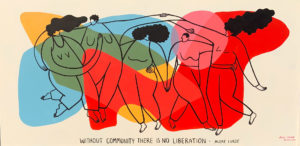The ethical foundation of yoga bursts with inspiration and guidance beyond a quote or shared moment of intention in class. Yoga’s ethical system draws on the yamas and niyamas. They are a set of principles outlined in The Yoga Sutras of Patanjali. They are considered to be a cornerstone of yoga’s philosophical foundation. The teachings are not only meaningful on the mat but can be applied in daily life and in actions of activism as well.
The Yamas and Niyamas
Postures and physical movement are an important part of yoga, but there are actually eight limbs to the practice (1). Asanas (poses) are the typical offering in yoga classes (2). Some classes also include pranayama (breathwork) and dhyana (meditation)(3). Yama and Niyama are two important and integral limbs of yoga that are difficult to teach in an hour-long studio class.

Yama and niyama are considered the foundation for yogic ethics (4). These teachings originate from The Yoga Sutras of Patanjali, a foundational yogic text. Since their origin, the principles have been translated, studied and debated by countless yogis. As a result, much has been written about these two limbs of yoga. Different experts suggest different interpretations, but the basics are agreed upon:
The Yamas (5):
- Ahimsa: nonviolence/active love
- Satya: truthfulness
- Asteya: non-stealing
- Brahmacharya: non-excess
- Aparigraha: non-greed
The Niyamas (6):
- Shaucha: purity
- Santosha: contentment
- Tapas: self-discipline
- Svadhyaya: self-study
- Ishvara Pranidhana: self-surrender
There is much to learn about each yama and niyama, and continued study is part of many yogis’ practices. For this post, we focus on the first two yamas, ahimsa and satya, and explore their connections to activism.
Ahimsa: Nonviolence and Active Love
 Ahimsa is the very first yama and is often translated to mean nonviolence. Some examples of living this ethic are simple: refraining from physical violence, not using violent speech, and avoiding hurtful thoughts of others. Digging deeper, one finds that ahimsa is more complex.
Ahimsa is the very first yama and is often translated to mean nonviolence. Some examples of living this ethic are simple: refraining from physical violence, not using violent speech, and avoiding hurtful thoughts of others. Digging deeper, one finds that ahimsa is more complex.
Some interpretations reveal nonviolence to mean the opposite of violence, suggesting this means a state of unconditional love for all beings, free of attachments and expectations normally associated with love. Active love poses a much greater challenge as it requires proactivity and a positive role, instead of simply avoiding bad acts. As one example goes, ahimsa means more than not scattering thorns in someone’s path but also decorating the path with flowers (7).
Ahimsa in Activism
When applying this ahimsa to activism, one is faced with the sometimes-uncomfortable idea of viewing the opposition as someone to be loved and wished well. This means protestors arrested while calling for social justice would love and want good things for the police taking them into custody. It means everyday citizens taking action against corrupt political figures still care for and have concern for the adversary.
Activism guided by ahimsa is social action based on love, not anger or hatred. This seems impossible, especially when considering deeply personal issues like: immigration reform, police brutality, voting rights, feminism, and LGBTQ+ rights. Consider, though, the idea that the opposition is not inherently evil. Maybe you fundamentally believe they are wrong, maybe they behave unjustly, but imagine this sparking concern in you instead of anger. What if a show of caring on your part while opposing them could help them? In this way, activism becomes an act of love not only for those you support but also for those you oppose (8).
Satya: Truthfulness
 Satya is the second yama and is usually defined as truthfulness. This guideline seems simple on the surface, don’t lie! While that may be a good rule, it doesn’t come close to the real meaning behind satya. This yogic ethic is about holding to the truth of what and who a person truly is.
Satya is the second yama and is usually defined as truthfulness. This guideline seems simple on the surface, don’t lie! While that may be a good rule, it doesn’t come close to the real meaning behind satya. This yogic ethic is about holding to the truth of what and who a person truly is.
Yoga philosophy teaches that moods, emotions, labels, identities, and names are all layered on top of a person’s true nature, but they are not the true person. According to these teachings, peeling back those superficial layers and getting in touch with this essence is a way to connect with the highest truth of the self (9).
Living with satya challenges a person to engage with the truth every day. For instance, if a person is so afraid of causing harm that they never speak up against harmful or hurtful behavior, is that person being true to themselves? Should they avoid a difficult conversation with a loved one about that inflammatory Instagram post? Is it best to avoid speaking up to a colleague about an inappropriate comment in the breakroom? Yogic philosophy suggests that, despite the discomfort and challenge, it is more important to be authentic than to be non-confrontational.
Satya: Truth is Not Always Universal
 Another crucial and challenging aspect of this yama is the idea that, according to yogic philosophy, truth is not always universal. Truth can be contradictory and can change and evolve. This seems completely at odds with the way people normally think. But, satya challenges yogis to open their minds to multiple versions of the truth (10). This can be extremely important for activists operating in spaces where they are not experiencing injustices themselves. For instance, when a White activist participates in activism for Black Lives Matter. It is crucial for that White activist to listen with an open and honest heart. The White activist may not live the Black experience, but that does not make the Black experience any less real or meaningful. As an activist, this can mean engaging in nonviolent communication (11).True listening requires a desire to understand and hold space for another without a self-serving motive.
Another crucial and challenging aspect of this yama is the idea that, according to yogic philosophy, truth is not always universal. Truth can be contradictory and can change and evolve. This seems completely at odds with the way people normally think. But, satya challenges yogis to open their minds to multiple versions of the truth (10). This can be extremely important for activists operating in spaces where they are not experiencing injustices themselves. For instance, when a White activist participates in activism for Black Lives Matter. It is crucial for that White activist to listen with an open and honest heart. The White activist may not live the Black experience, but that does not make the Black experience any less real or meaningful. As an activist, this can mean engaging in nonviolent communication (11).True listening requires a desire to understand and hold space for another without a self-serving motive.
Yogic Ethics in Life
There is no question that the modern world can feel overwhelming and stressful. Across the globe, the COVID-19 pandemic continues to impact economies, healthcare systems, and entire communities. In the United States, political tensions have reached unprecedented levels and appear to reach a new boiling point each day. It can be tempting to think yoga might be pointless; after all, it is impossible to “om” it all away. But don’t lose heart! Here are two small but significant ways to practice ahimsa and satya every day:
Ahimsa Journaling
 Yoga District encourages its teacher training students to maintain an ahimsa journal as part of their training to learn and embody this yama. In this practice, a journal writer has two opportunities to reflect on their day and the practice of ahimsa. In the morning, look to the day ahead: where can you show active love in thought, word, and deed? What specific activities might challenge you, and how can you proactively embody ahimsa and keep positive, active love in mind? What will you refrain from that might cause harm to others or yourself? In the evening, look back over the day and reflect: where was ahimsa challenged? Why might it have been challenging? What did you learn? How do you feel? This can help develop a personal interpretation of ahimsa and provides an opportunity to reflect on yoga in one’s daily life, not just on the mat.
Yoga District encourages its teacher training students to maintain an ahimsa journal as part of their training to learn and embody this yama. In this practice, a journal writer has two opportunities to reflect on their day and the practice of ahimsa. In the morning, look to the day ahead: where can you show active love in thought, word, and deed? What specific activities might challenge you, and how can you proactively embody ahimsa and keep positive, active love in mind? What will you refrain from that might cause harm to others or yourself? In the evening, look back over the day and reflect: where was ahimsa challenged? Why might it have been challenging? What did you learn? How do you feel? This can help develop a personal interpretation of ahimsa and provides an opportunity to reflect on yoga in one’s daily life, not just on the mat.
Three Questions for Truthfulness
Speaking truthfully is the most obvious way to embody satya, but it can still be difficult! One common way to practice satya in speech is to ask three questions before speaking what is on your mind. First, is this true? If not, stop there. If so, proceed to the next question: is it necessary? If not, pause and reconsider. If so, ask yourself the final question: is it kind? This is the final question to consider before speaking. These questions are not foolproof, but they are an excellent place to start when wondering whether sharing a thought would align with yogic ethics.
 Keep Practicing
Keep Practicing
Just as the practice of yoga evolves over time, so too can the understanding of yoga. Consider this an early step in a journey to learning more about yoga, activism, and how the two practices can support each other. Above all else, remember to be active in love and truthful in thought, word, and deed. By living these values, the world is already becoming a better place.
Sources:
- The Yoga Sutras of Patanjali, http://www.gutenberg.org/ebooks/2526
- Asanas, https://www.yogapedia.com/definition/4951/asana
- Dhyana (meditation), https://www.ncbi.nlm.nih.gov/pmc/articles/PMC3573536/
- Yoga’s Ethical Guide to Living: The Yamas and Niyamas, https://kripalu.org/resources/yoga-s-ethical-guide-living-yamas-and-niyamas
- Yamas, https://www.yogapedia.com/awaken-the-foundation-a-journey-through-the-yamas/2/12061
- Niyamas, https://www.yogapedia.com/the-second-step-of-yoga-niyama/2/8856
- The True Meaning of Ashima, https://www.srmd.org/en-US/wisdom/articles/pujya-gurudevshri/pujya-gurudevshri-insights/the-true-meaning-of-ahimsa/
- The Power of Loving Activism, https://www.ramdass.org/loving-activism-love-time-chaos-part-5/
- Satya-Being Truthful, https://www.artofliving.org/us-en/5-ways-to-practice-satya-being-truthful-second-yama-of-yoga-sutras
- 5 Ways to Practice Satya, https://www.artofliving.org/us-en/5-ways-to-practice-satya-being-truthful-second-yama-of-yoga-sutras
- Center for Nonviolent Communication, https://www.cnvc.org/learn-nvc/what-is-nvc


